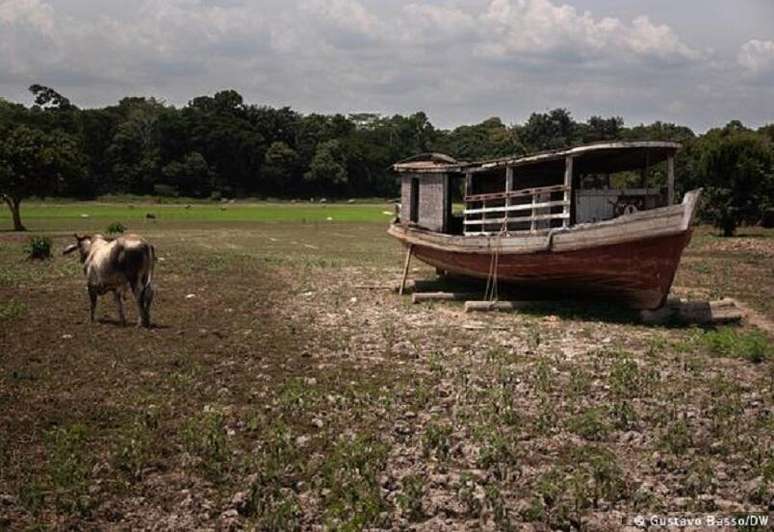Climatologist Carlos Nobre warns that the forest could disappear if global warming is not contained and deforestation is stopped.
A this year’s drought in the Amazon it created a scorched earth scenario. With rivers at historic lows, entire communities are isolated and have difficulty accessing food and drinking water. The dry climate also contributed to the situation proliferation of fires, which destroy forests and plantations and pollute the air.
The increase in severe droughts in the Amazon represents a warning about the region’s present and future. The scientific community is warning this climate changes and deforestation can lead to forest death. This degradation process would generate enormous carbon emissions, deregulate the continent’s rainfall system and cause the extinction of hundreds of species endemic to the biome.
Global warming and stronger El Niños cause more frequent droughts in the Amazon (Photo: Gustavo Basso-DW)
In an interview with DW, Carlos Nobre, climatologist at the National Institute for Space Research (INPE) and a global point of reference in climate change studies, spoke about the current drought in the region, the possible irreversible collapse of the forest and how to reverse this process.
DW: Your studies indicate that the Amazon could lose its characteristics of a humid tropical forest and become a desert biome, similar to the Cerrado, subjected to so-called “savannization”. How would this process happen?
Carlo Nobre: This would occur due to the fact that The climate in the Amazon is changing. First, we have global warming, which causes a very long dry season in much of the Amazon. Along with this there is also deforestation. Pastures recycle much less water than forests. The dry season is already four to five weeks longer in the southern Amazon, which runs from the Atlantic to Bolivia, four weeks in the forest and five weeks in heavily deforested areas.
OR the start of the rainy season is late. Previously, in the southeast of the Amazon, it started at the end of September, now it starts at the end of October. All the the dry season lasted three to four months, now it lasts four to five months. When it reaches five to six months, it becomes the climatic envelope of the tropical savannah.
If it continues at this rate, the forest will degrade and be replaced by degraded open vegetation, with very few trees and very little carbon storage. It will no longer be the forest of the closed sky.
The current drought is already historic. Can it be seen as a symptom of this desertification process?
OR Global warming is causing more frequent droughts. We have had five droughts in the Amazon in less than 20 years: 2005, 2010, 2015 and 2016, 2022 and now, 2023. This year’s drought is very strong, if it continues at this level, it could even break the drought record recorded in 2015 and 2016.
These droughts have to do with the El Niño phenomenon in the Equatorial Pacific Ocean. But severe droughts used to be rare and now occur with enormous frequency in the southern Amazon. Stronger El Niños are occurring. All this accelerates the degradation of the forest and this process of drastic change of its biome, which can occur if the point of no return is reached.
Where are we now? If we continue at this rate of deforestation, when will we reach this critical threshold?
Deforestation is already at 17%. In recent years, the Amazon has increased deforestation by 1% every four years. Continuing at this rate, deforestation would reach 20% in less than two decades. According to the latest COP 27 commitments, the temperature increase would reach 2.4-2.6°C in 2050. Thus, by 2050 at the latest we would have reached the point of no return. But We are already seeing an increase in mortality and the length of the dry season. This is already happening across the southern Amazon.
Can we reverse this desertification situation?
Some scientists even say that the southeastern Amazon has already reached the point of no return, in this region where tree mortality has increased and the forest has become a source of carbon. But many scientists like me think not.
If we can eliminate deforestation, degradation and fires, and create a major forest restoration project across the southern Amazon, we can reverse the trend. Once the secondary forest regenerates, it can absorb a lot of carbon, lower the temperature and recycle water very efficiently, preventing the arrival of no return.
Could extreme degradation in the southern part compromise other regions of the Amazon?
It compromises the other parties, because the entire forest recycles much less water. So winds carry less water vapor to the west of the Amazon, for example, which will be more vulnerable and may even degrade.
With the Amazon entering this extreme process of degradation and desertification, what would the consequences be for the rest of the country and the world?
A The Amazon provides a range of ecosystem services. It stores a large amount of carbon in the soil and calculations indicate that if we pass the point of no return, within 30 to 50 years, the region will release about 250 billion tons of carbon dioxide into the atmosphere. This would make it even more difficult to achieve the goals of the Paris Agreement, the temperature would increase by a further 0.3 – 0.4°C.
A the forest also regulates the temperature of the Amazonif it is replaced by this degraded ecosystem or by pastures and livestock, the temperature will increase in the order of two-three degrees, and the wind that crosses the Amazon and descends into the Cerrado will arrive warmer, further increasing the risks for this biome.
A the forest recycles a large amount of water. If it passes the point of return, it begins to recycle less water and export much less water vapor, so-called flying rivers. These rivers feed rain systems in the southern Amazon, the Cerrado, central, southern Brazil, east-central Argentina, Uruguay, Paraguay, the Andes, and also in the southeast. Furthermore, the Amazon has the greatest biodiversity on the planet. Savanization will greatly affect hundreds of thousands of endemic species that exist only in the Amazon. They will disappear. And, of course, this poses a great risk to the ecosystem, for example the risk of epidemics and pandemics.
Can we say that there has been an increase in extreme events in the Amazon region and will they become more common in the coming years?
Those extreme events are now more common. This is due to the fact that the the temperature until last year had increased by 1.15°C compared to the average temperature from 1850 to 1900. In the world, the months of June, July, August and September were the four hottest in history, as long as historical documents exist, and also based on geological data that reveal an even more distant past. The temperature has never been so high. As a result, extreme events, such as stronger El Niños, are already occurring across the planet and also in the Amazon.
What solutions do you propose to eliminate illegal deforestation and ensure that people can live in the Amazon with decent livelihoods and certain infrastructure, without degrading the forest?
First, we need a immediate action against deforestation in the southern Amazonwhy this very close to the point of no return. And then bring deforestation to zero across the Amazon by 2030. This year we have the good news of a huge reduction in deforestation in the Brazilian Amazon, by 50% by September compared to the same months in 2022, it has reduced also in Colombia, Peru, Ecuador.
I took part in the creation of the Arcos da Restauração Florestal project, which aims to create perhaps one of the the largest forest restoration projects in the worldand restore at least 500 thousand km² of forest, a quarter of the 2 million km² deforested and degraded throughout the Amazon.
Finally, we must look to nature-based solutions. Developing a new economy for the Amazon. An economy based on the knowledge of indigenous populations and local communities, on agroforestry systems and on biodiversity products. Indigenous people have lived with the forest for thousands of years and have developed very important indigenous science, we must take advantage of this knowledge.
Source: Terra
Rose James is a Gossipify movie and series reviewer known for her in-depth analysis and unique perspective on the latest releases. With a background in film studies, she provides engaging and informative reviews, and keeps readers up to date with industry trends and emerging talents.







